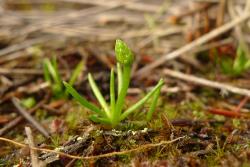Terrestrial plants. Stems erect, unbranched, growing from a subterranean tuber. Roots forming a single basal tuft. Leaves whorled at ground level, terete, linear. Bulbils absent. Sporophylls markedly different to the leaves, aggregated into distinct strobili, ephemeral. Strobili solitary, erect, terminal on leafless stalk. Spores foveolate or fossulate, triangular in polar view with convex lateral margins, and foveolate sculpture only on the distal surfaces.
A monotypic genus (PPG 1 2016). Phylloglossum is a highly specialised genus which has been recognised for over 150 years. It belongs to the huperzioid clade of Lycopodiaceae (Field et al. 2016) but is morphologically distinct from both Huperzia and Phlegmariurus. It is a tiny terrestrial plant with a subterranean tuber, a basal rosette of linear leaves, and a small strobilus borne on a leafless stalk, quite unlike any other member of the family.
A monotypic genus confined to Australia and New Zealand, where it is adapted to seasonally wet conditions, surviving the dry season as an underground tuber. One indigenous, non-endemic species in New Zealand.
| Category | Number |
|---|---|
| Indigenous (Non-endemic) | 1 |
| Total | 1 |
Blackwood (1953) reported a single count of n = 246 II + 10 I from Australian material of Phylloglossum drummondii.
The gametophyte of Phylloglossum in New Zealand has been examined in detail by Holloway (1935) and Whittier & Braggins (1992, 2000).




